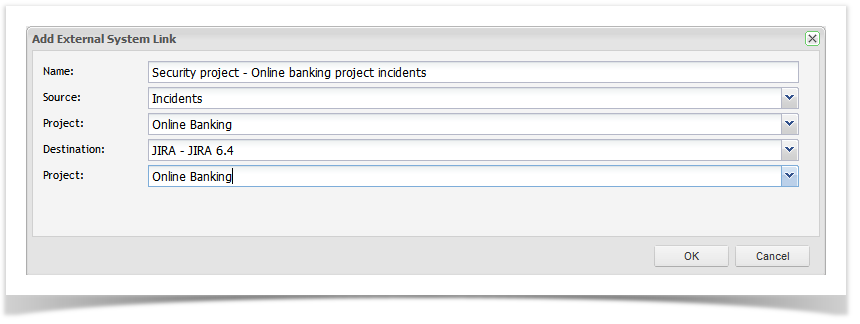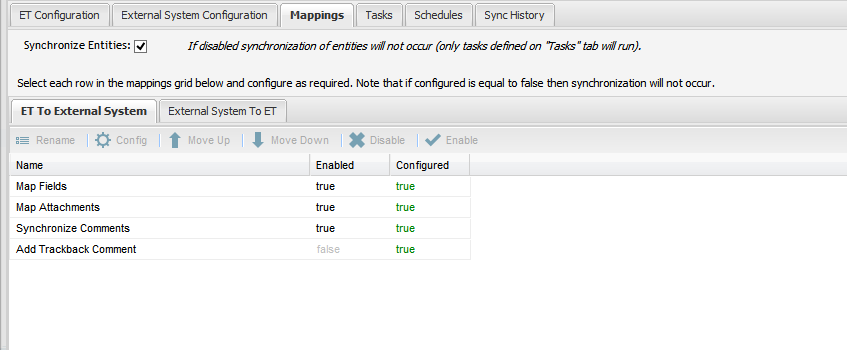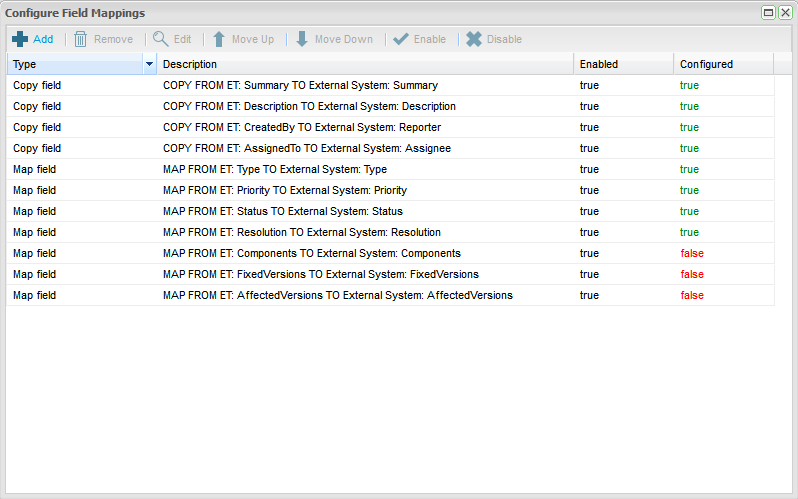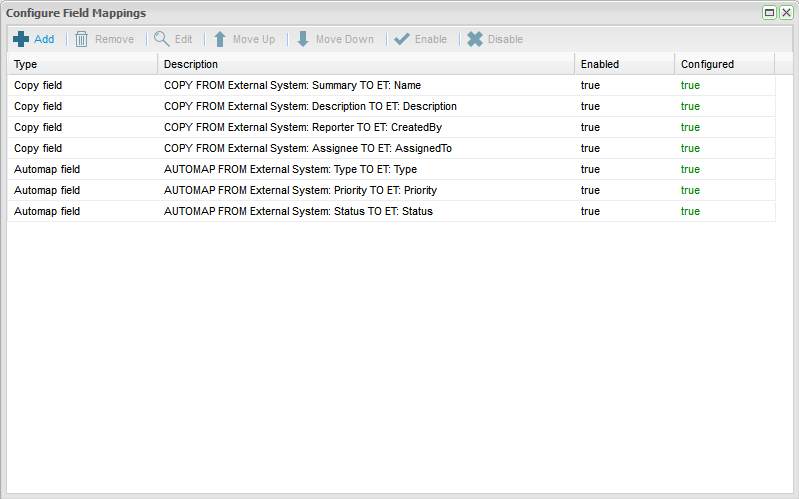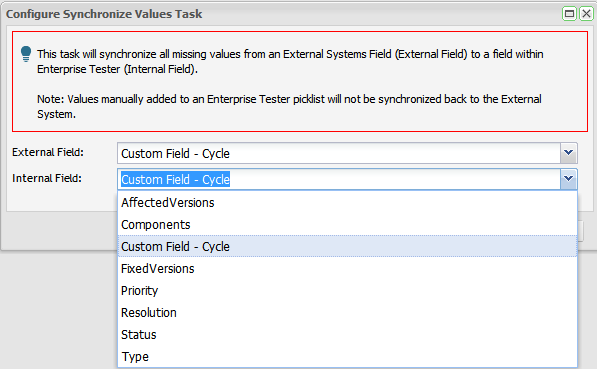...
To create a new project link select Add from the toolbar, or from the navigator you can right click on your project and select "Add New Project Link" from the menu.
Complete the details selecting the JIRA connection that you created in the steps outlined in the above section, and your JIRA project to link to. Now click on 'OK'.
Once the project link to JIRA has been created, Enterprise Tester will initiate a refresh of all the metadata. This may take a few minutes.
...
Once you have created the incident project link, the Edit Synchronization Configuration screen will appear.
Enterprise Tester Configuration
...
When a project link is created a refresh lookups Refresh Lookups kicks off. This process finds all the JIRA field values for your project to populate the picklist (select list) for this screen. If you do not see any JIRA values in the drop down list or an incomplete list is presented, click on Refresh Lookups to update the picklist values.
Field Configuration — Mappings
On the mappings tab, the Synchronize Synchronize Entities option is pre-selected. The selection of this option will ensure that incident and tasks are synchronized. If the Synchronize Entities is not selected, then only the Tasks will run. See the Task section for more detail.
...
The Map Fields activity is the only configuration you will need to complete on this screen. Note that it is the only activity that displays false in the Configured column. To configure the field mappings, click to select Map Fields and click Config from the toolbar.
The Configure Field Mappings screen will appear and all Enterprise Tester inbuilt fields have pre-set mappings to JIRA inbuilt fields.
Some fields will require mapping or confirmation of the pre-configured mappings. These will be marked as false in the Configured column.
Several configurations are automatically created, consisting of Copy Field type mappings and direct Map field type mappings.
The Copy Field type mappings are already configured and the value will be copied from Enterprise Tester to JIRA on Synchronization:
...
The Map field type mappings require the field values to be mapped. You can see under the column “Configured Configured = False” False that the values for these fields have not yet been mapped:
...
To complete the field mappings, click on the field row and select Edit from the tool bar or double click on the field row.
Complete mapping Enterprise Tester field values to JIRA field values. Where picklist values in Enterprise Tester and JIRA are exact matches, the mappings will be automatically configured.
Click Save Changes.
Complete mapping field values for all fields following steps 1-3.
...
Note that all activities are pre-configured including the Map Fields activity. To view the fields that are pre-configured to synchronize, click on Map Fields and then click Config from the toolbar.
The Configure Field Mappings screen will appear and a number of JIRA inbuilt fields have pre-set mappings to ET inbuilt fields. These are configured as either Copy Field or Automap field type mappings.
...
Adding New Field Mappings — Configuring Custom Fields
Custom Fields can be synchronized from Enterprise Tester. Set up is required to select and configure the fields that you wish to synchronize.
From the Map Fields screen, you can add a new field to the synchronization configuration. To do this click on Add on the Configure Field Mappings screen.
The Add Mapping dialog dialogue will appear.
Select the type of mapping you wish to create:
...
| Type | Description |
|---|---|
Automap Field | Automap Field mapping will automatically map all matching field values in Enterprise Tester and JIRA so that it is not necessary to do this manually. In addition when synchronizing in the JIRA to Enterprise Tester direction, new field values detected on synchronize from your external system (JIRA) will be added to the Enterprise Tester field value picklist if they don't already exist. Using this type of field mapping eliminates duplicate field management in JIRA and in Enterprise Tester. It will also allow incident synchronization to complete even when map values already exist. This type of mapping is useful for fields like Versions and Components which tend to continually grow. This type of mapping should be used when your picklist values in Enterprise Tester and JIRA are the same. Supported field types include, Combo box (select lists), multiselect list, radio button groups and checkbox groupsMultiselect List, Radio Button Groups and Checkbox Groups. *Note: that this feature does not synchronize the picklists between JIRA and Enterprise Tester but it does add values to the Enterprise Tester picklists when new values are detected on incidents during synchronization. |
Copy Field | Copy field will copy the text from your JIRA issue to the mapped field in Enterprise Tester. This is recommended when synchronizing text fields. |
Set Field to Value | Set field to value field mapping allows you to specify a value to populate the field in Enterprise Tester with regardless of the values in JIRA. All Field types are supported. |
Set Field to Value (if it's null or empty) | Set field value field mapping allows you to specify a value to populate the field in Enterprise Tester with, if the field does not currently have a value set/is null. All Field Types are supported. This mapping type is useful for setting a default value, if the value was not populated by a previous mapping (and so when used in this way, the mapping should appear at the bottom of the list of field mappings). |
Map Field | The Map field option allows you to manually map the field values in Enterprise Tester with those of JIRA. This is useful when your your picklist values in JIRA are different to your picklist values in Enterprise Tester. Enterprise Tester will automatically map any exact value matches when first displaying the mapping configuration screen. Supported field types include: Combo box (select lists), multiselect list, radio button groups and checkbox groups. |
...
If the field value is null or empty you can set the field to be set to a specified value. For this configuration select the field and the value to set.
Map
When using the map field Map Field configuration, you will be required to manually map the field values. This is useful when the values in Enterprise Tester and JIRA are different or if you have more than one value that will map to the same value in the other system.
...
Another point to note when configuring your field mapping configuration for "Automap" or "Map" type mappings is that you may need at least one value in your JIRA picklist (configurable set of allowable values) for the field (drop down list, checkbox list etc.) for the field to be detected as a configurable field for these mapping types. After adding your value(s) to JIRA you may need to perform a refresh lookups Refresh Lookups before the field will be detected.
...
In addition to synchronizing requirements and incidents between JIRA and Enterprise Tester you can also set up tasks to synchronize picklist field values. A good example of when this would be useful are the fields Versions and Components.
Versions and Components are normally being added to over time — and this can be a burden to then have to replicate these changes in Enterprise Tester manually.
A good way of managing the consistency of the field values in JIRA with the field values in Enterprise Tester is to set up a task to update the full list of picklist values on synchronization. This will ensure that your picklist values are always up-to-date with the field value list in JIRA without having to manually manage the task.
...
This feature supports both inbuilt and custom fields. The following field types are supported: combobox Combobox (single select list), multiMulti- select list, checkbox group, radio button groupSelect List, Checkbox Group, Radio Button Group.
To set up a picklist synchronization task. Navigate to the Task tab on your project link configuration screen.
Click on Add from the toolbar and enter in a name for your task and click OK.
Next, select your JIRA Field and your Enterprise Tester Field and click on Save.
The task is then created, and is displayed in the tasks grid.
...
When synchronizing from JIRA to Enterprise Tester, links between issues in JIRA are not synchronized to relationships in Enterprise Tester.
Auto-map from Enterprise Tester to JIRA is only supported for the component and version fields, and its use is generally discouraged (adding versions and components to your defect tracker generally makes more sense, so that you can populate additional information such as component lead, due date etc. — which Enterprise Tester does not support).
JCAbt#wjNmq$Xt*!5013sF^W

